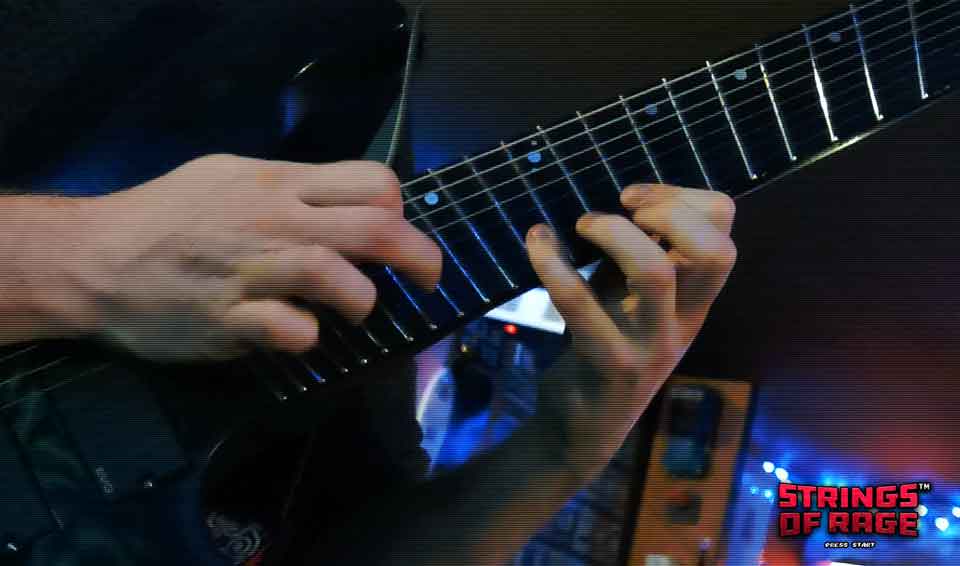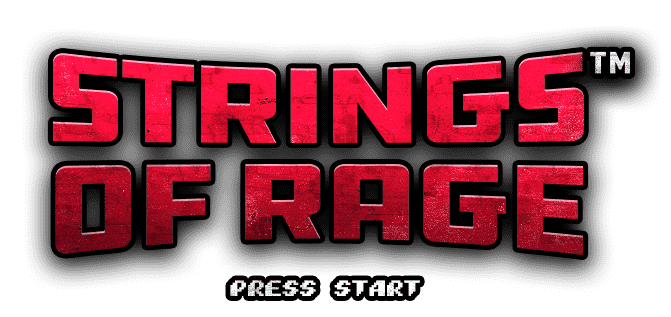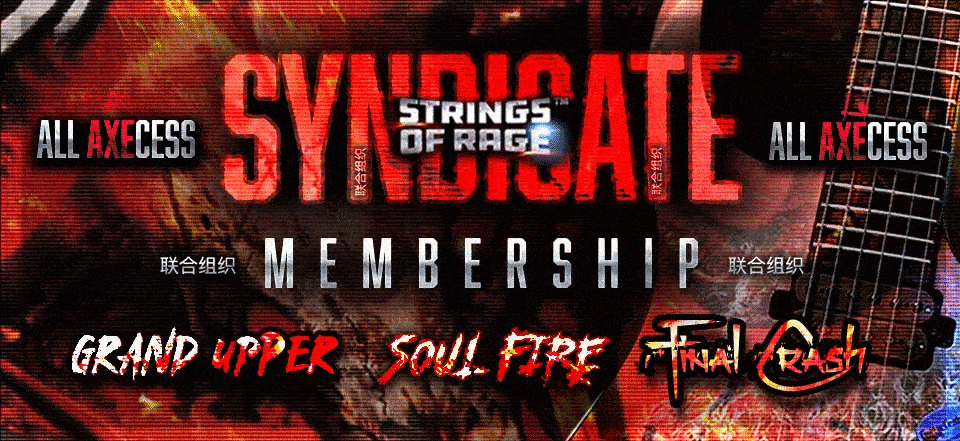By popular demand of our Syndicate Members, in this lesson we’re going to be covering some really unorthodox, ways to play & map out pentatonic and blues scales. We’ll of course be covering these ideas on both 6 and 7 string guitars. If you’re observant you should be able to apply these to 8 string as well. Go Straight!
If you’ve been following us for a while now you’ll know we are massive fans of advanced pentatonic scales. Not just your typical box pentatonics, oh no, there’s nothing cool about single position 2nps pentatonic boxes. We’re all about progressing ideas on the instrument and discovering new ways to do things. So in this lesson we’ll be looking at unconventional uses of the pentatonic and blues scales. All these examples will use the minor pentatonic scale but if you understand the concepts you’ll be able to translate them to the major pentatonic too. Included in this guide is the dreaded three note per string pentatonics. Brace yourself.
We’ll be covering a ton of really cool ideas so get ready, you’ve never seen pentatonics like this before!

Contents for This Lesson:
Use these links to jump to the section of interest or start from the top to cover everything.
01: Pentatonic Intervals →
02: Basic Box Shapes →
03: Beyond The Basics →
04: Reverse Pentatonics →
05: 3nps Pentatonics →
06: 3nps Blues Scales →
07: Warped Blues Scales →
08: True 3nps Pentatonics →
09: Mixing 3nps & 4nps →
10: String Skipped 4nps Ideas →
11: Intervallic Pentatonic Ideas →

Intervals of the Pentatonic Scales
In order to understand any scale or arpeggio properly, a thorough understanding of its intervals, and even intervals in general is the most important concept here. Let’s quickly look at the intervals of the major and minor pentatonic scales.
We’re going to quickly skim over the basics and then rapidly get into the cooler more advanced ideas!
Minor Pentatonic Scale Intervals: R, b3, 4, 5, b7
Major Pentatonic Scale Intervals: R, 2, 3, 5, 6

Basic Minor Pentatonic & Blues: 2nps Box Shapes
It’s old, tired and worn out – but here it is, the Minor pentatonic scale in all its two-note-per-string glory. For good measure and to please Gene and Eric we’ll even show it in the key of A-Minor for you as well. If you don’t already know the ‘modes’ of the pentatonic scale then you can check out the basic pentatonic lesson. How’d you like them apples!
Minor Pentatonic & Blues for 7 String
Here’s the basic A minor pentatonic scale shape for all you 7 stringers out there. You can of course move it to other keys. We did another lesson on 7 string pentatonics which would be worth checking out. That lesson is exclusively for 7 string and shows you all the standard box shapes as well as some of the advanced pentatonic scales and ideas we’ll be covering here too.


Advanced Pentatonic Scales Across The Neck
The first things to do to start advancing your pentatonics, regardless of how many strings you have, is to map out your pentatonics across the neck. Linear style.
BUT, before we turn them into 3nps pentatonics, lets look at a couple of cool ideas you can do using octaves.
Pentatonics for Six String Guitar
The following four examples will show two linear minor pentatonic and blues concepts for six string guitar players.
Advanced Pentatonic Scales for Seven String Guitar
The following four examples will show two linear minor pentatonic and blues concepts for seven string guitar players.


Using Pentatonics ‘In Reverse’
In this section we’ll briefly look at some linear pentatonics that go towards the nut or from the nut end of the guitar, depending on how you play them. You should be able to break up your scales in any direction across the neck. Playing scales and arpeggios in a ‘reverse linear’ way will help your fretboard visualisation.
The goal here is to use the concept and apply it to the other positions of the scale and ultimately beyond that, to any scale you choose.
!!HEADS UP!!
You’ll need to be creative with the way you play these to avoid a repeat note, I like to use slides to transition between positions but there are many ways you could do it.

Three Note-Per-String Pentatonics
Ah! The dreaded, the rarely talked about, three note per string pentatonic! We take no prisoners so strap in tight for this section!
We’re going to have a multitude of different variations here, we’ll have 3nps that repeats in octaves and then we’ll have ‘true’ 3nps pentatonics. You’ll quickly notice if you try and do 3nps pentatonics either in one position or using octaves you’ll get a repeat note.
There’s a few cool ways to avoid this but you’ll need to download the GPRO tab to find out how! Strings of Rage Syndicate Members have all axe-cess to lesson material at the bottom of each lesson.
3nps ‘Clone Tone’ Pentatonics Using Octaves
Creativity is the key here – come up with sequences and motif’s to avoid the repeat note.

Three Note-Per-String Blues Scales
These 3nps blues scales are really cool because you don’t get any repeat notes at all. You simply have six notes across two strings and the octave starts the pattern over again. These are obviously great for 3nps linear picking runs but there are many more things than can be discovered with these shapes.
We’ve shown two of our favourites here on both six and seven string. When it’s released, Syndicate members get access to the both the GPRO Tabs file and PDF lesson book where we’ve mapped out all the variations that can be done, it’s going to be a killer resource, sign up and we’ll ping you when it’s ready.

‘Warped’ Blues Scales for 7 String Guitar
Damn! At first glance these look absolutely ridiculous, and actually they are. HOWEVER these really wild and unconventional shapes will help you to break away from conventional scale fingerings which is incredibly helpful. You’ll also find you will phrase differently with a shape like this because it’s forcing you to adapt to new fingerings in order to execute them.
These are loosely based on a 3-1-3 economy picking idea with the additional notes up or down to the root on the high E and low B. Obviously though, and I would encourage you, to not just play them straight up and down. If you can blaze through them with economy picking though, it’ll guarantee to turn some heads.


True Three Note Per String Pentatonics
These ideas are truly wild and cover near enough the whole neck because of the large intervals. We’re going to just show one example for minor pentatonic in root position. Syndicate Members can download the book for this lesson which provide you with all the other shapes. However, we’d encourage you to work them out yourself using your knowledge of intervals.

Mixing 3 and 4nps Pentatonics
As scary as this stuff may sound, given the intervals of pentatonics, if you can get to grips with these concepts and ways of visualising these scales, it’s going to massively up your game. The goal is to use these advanced pentatonic scales come up with lines and ideas that avoid the repeat note that take advantage of the intervals of the scale.

Advanced Pentatonic Scales Using 4nps & String Skipping
If you’re like most players and have average sized hands then playing these ideas lower than fret 12 becomes pretty impossible. As always though, mix it up, if you can play them straight up and down with a 4nps stretch that’s awesome, but use the concepts to come up with your own badass ideas! Just like the other examples there’s a single example of these advanced pentatonic scales here for 6 and 7 string guitar. We really like these ideas because you’re playing a 5 note scale with a 4 note pattern.

Advanced Pentatonic Scales Using Wider Intervals
To complete this lesson we’re going to show some of our absolute favourites! This concept is really cool because it uses all 5 notes of the pentatonic scale but not in interval order. Skipping notes allows you to take advantage of some of the wider intervals in this scale. Here’s some examples for both six and seven string guitars.

You’ve Finished the Stage!
That’s it for this lesson – well done if you’ve made it all the way to the bottom. We really hope these ideas are helping to push the boundaries in your own playing and have opened your eyes to some new posibilities that can be done with the standard pentatonic scales. Hopeful you’re getting to grips with these concepts and if you are you can start to apply them to other scales and modes too!

More Pentatonic Scale Lessons
Hopefully you love advanced pentatonic ideas as much as we do. Check out these other lessons we’ve done on alternative pentatonics, they’re equally as good as this lesson. Cheers and please consider joining the Strings of Rage Syndicate membership to unlock additional perks!












No Comment